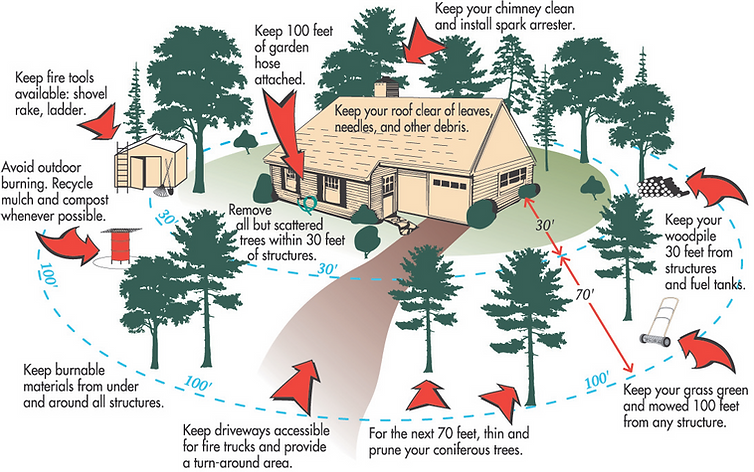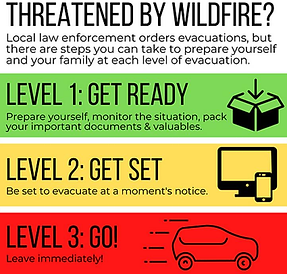Wildfire
Wildfires, or brush fires, are uncontrolled fires that burn in natural areas like grasslands and forests. They are caused most often by human actions (both accidental and intentional) or lightning. These dangerous fires spread quickly and can devastate not only wildlife and natural areas, but also the built environment. Whether they start from a lightning strike, an unattended campfire, a spark from a train or vehicle, or a downed power line, wildfires can be an incredibly destructive force. Some of them grow so large that they can also create a fire storm. Widespread smoky conditions also present a health risk to children, pregnant females, older adults, and people with asthma, heart disease, or lung conditions. The Florida Forest Service maintains a public website that monitors fire weather and provides current wildfire information, including maps of active wildfires and county burn-bans throughout the state.


Most Florida communities are part of the wildland urban interface, meaning they are near forests or wooded areas and are at risk for wildfire. Twenty-five years ago, heavy vegetation from the previous year's above-average rainfall, died from drought and served as kindling for extreme wildfires in Florida. Nearly 500,000 acres burned from April through July, forcing more than 120,000 to leave their homes, including the entire population of Flagler County. Health impacts ranged from burns and heat-related illnesses to respiratory issues, mental health struggles, and car crashes. A reported 10,000 firefighters, including those from 40 other states, responded to the fires burning in all 67 Florida counties.
Fortunately, the Firewise USA Program has simple steps homeowners can take to help reduce the chances of a catastrophic wildfire, including creating defensible space around the house, burning yard waste safely outdoors, utilizing prescribed burning, and quickly reporting a potential wildfire or suspicious arson activity. Residents are encouraged to collaborate to increase defensible space in each neighborhood. Click HERE to download the Ready, Set, Go! Wildfire Preparedness Handbook.

Before

During

After
-
Check the forecast regularly. Listen to local news or a NOAA Weather Radio to stay informed about fires in dry weather.
-
Sign up for the National Weather Service's through the AlertNassau notification system.
-
Use fire-safe construction materials to build, renovate, or make repairs. Trim branches away from the house. Keep your roof and gutters clear of debris.
-
Use fire-resistant landscaping and create a defensible zone that is free of leaves, debris, or flammable materials for at least 30 feet from your home. Keep grass, plants, and other vegetation around your living area well hydrated.
-
Locate an outdoor water source and a hose that can reach any area of your property.
-
Stay mindful of current weather conditions when open-burning landscape debris.
-
Understand NWS Fire Weather terms and what to do:
-
Fire Weather Watch: Be Prepared. Weather conditions are are favorable for wildfire to spread easily, but wildfire is not yet occurring.
-
Red Flag Warning: Take Action. Be extremely careful with open flames; fire conditions are ongoing or expected shortly.
-
Extreme Fire Behavior: This alert implies a wildfire likely to rage of out of control.
-
-
Make a Plan. Identify escape routes and make sure all those residing within the home know the plan of action; decide how you will get in contact with each other, where you will go, and what you will do in an emergency, like sheltering with friends or family out of the area.
-
Build a Kit. Include N95 respirator facemasks that filter out particles in the air you breathe. Be prepared to evacuate! Keep in mind each person’s specific needs, including medication. Don’t forget the needs of pets.
-
Identify a room that can be closed off to outside air. Set up a portable air filter to keep the air in this room cleaner even when it’s smoky outdoors.
-
Keep important documents in a fireproof safe. Create password-protected digital copies and save them to the cloud.
-
Do not use open flames during fire weather. Spark arresters should be used on all portable gasoline-powered equipment, tractors, harvesters, chainsaws, weed-eaters, and mowers.
-
Motorists are responsible for many wildfires sparked along our roadways; follow these safety rules:
-
Never throw a burning item out a window.
-
Keep vehicles properly maintained, with nothing dragging on the ground. Brakes worn thin can cause metal to metal contact creating sparks.
-
Maintain proper tire pressure. Driving on exposed wheel rims will throw sparks.
-
Practice Safe Towing. Dragging chains throws sparks; use appropriate safety pins and hitch ball to secure chains.
-
Don’t drive vehicles onto dry grass or brush; hot exhaust pipes and mufflers can start fires.
-
Carry a fire extinguisher in your vehicle and learn how to use it.
-
-
Keep fire safety in mind when grilling and during outdoor celebrations.
-
Listen to NOAA Weather Radio and local alerting systems for current emergency information and instructions.
-
Leave immediately if authorities tell you to do so! Delaying the decision to evacuate leads to wildfire deaths.
-
If NOT ordered to evacuate:
-
Do not light campfires, bonfires, candles, or anything else that could blow over and start a fire.
-
If you smoke, extinguish cigarettes or cigars before disposing of them.
-
Bag up trash, clippings, and other easily flammable items.
-
Fill up your vehicle and pack emergency items in case you need to evacuate. Wildfire instructions can change quickly.
-
-
Use an N95 filtering facemask to keep ash particles out of the air you breathe. Take steps to protect pets and livestock from dangerous wildfire smoke, too.
-
Avoid using candles, gas, propane, wood-burning stoves, fireplaces, or aerosol sprays, and don’t fry or broil meat, smoke tobacco products, or vacuum.
-
If you have a central air conditioning system, use high-efficiency filters to capture fine particles from smoke. If your system has a fresh air intake, set the system to recirculate mode or close the outdoor intake damper.
-
If trapped, call 911 and give your location, but be aware that emergency response could be delayed or impossible. Turn on lights to help people find you.
-
Leave a ladder in sight and garden hoses connected to water spigots.
-
If you were told to evacuate, return home only when officials say it is safe.
-
Once home, drive only if necessary. If you must go out, watch for fallen objects in the road, downed electrical wires, and weakened walls, bridges, roads, and sidewalks that might collapse.
-
Walk carefully around the outside of your home to check for damaged power lines, gas leaks, and structural damage. Avoid hot ash, charred trees, smoldering debris, and live embers. The ground may contain heat pockets that can burn you or spark another fire. Consider the danger to pets and livestock walking around.
-
Stay out of any building in which you smell gas, see smoke or flames, or if the building or home was damaged by fire, or authorities have not declared it safe.
-
If power is out, use battery-powered flashlights; do NOT use candles. Turn on your flashlight before entering a vacated building. The battery could produce a spark that could ignite leaking gas, if present. Never use a portable generator inside your home or garage.
-
Send text messages or use social media to reach out to family and friends. Phone systems are often busy following a disaster. Make calls only in emergencies.
-
Document property damage with photographs. Conduct an inventory and contact your insurance company for assistance.
-
USDA offers programs that can help commercial greenhouse, honey bee, fish, livestock, silviculture, and other agricultural crop operations with wildfire recovery.








Disaster Preparedness
Federal Emergency Management Agency
National Flood Insurance Program
Natural Hazards - Risk Indeces
Document and Insure Your Property
Download the "Are You Ready?" Guide

Fire Rescue and Wildfire


